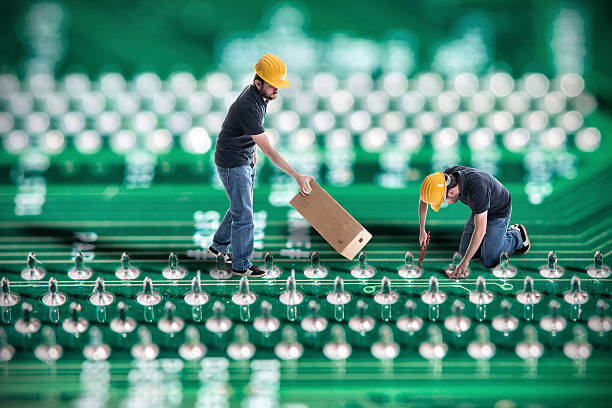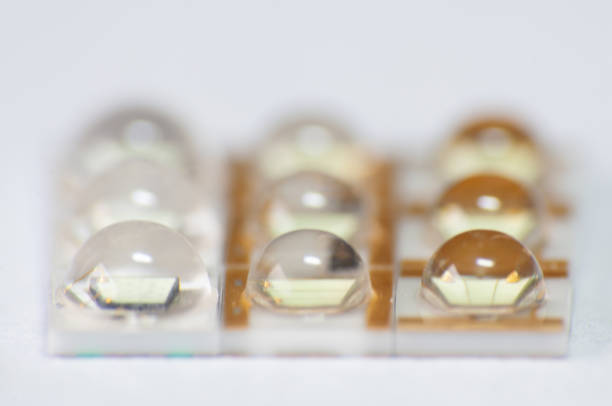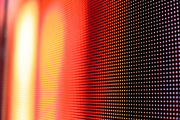What Are Small Pitch LEDs, Mini LEDs and Micro LEDs?
1. Brief introduction
In the past two years, as Apple has begun to use Mini LED as a backlight source, and it is rumored that Apple will use Micro LED as a display device for future AR products, the Micro LED and Mini LED industries have ushered in new growth points. BOE, TCL , Leyard and other domestic companies have also begun to deploy related industries.
So what is the difference between these three concepts? Today I will give a brief introduction.
2. Small pitch LED
The huge domestic LED production capacity ensures the development of the LED display industry, from outdoor plain text LED array screens, to huge LED billboards, and various “sky curtains” in various places, such as the World Trade Fair, to various large-scale literature and art The large-scale display devices behind the party are all small-pitch LEDs.
For example, in a performance, the LED screen was arranged like this:
The runway on the east side of the Bird’s Nest is set up with a 174-meter-long, 29.5-meter-high LED background main screen (12 4K resolution) with a total area of 5,133 square meters, and two flag-shaped side screens totaling 2,300 square meters.
The main stage area is equipped with a 30-meter-long and 9-meter-high LED movable floor screen.
Finally, an LED display combination with a total area of nearly 10,000 square meters was formed.
Such a combination is used to shorten the viewing distance, focus on the detailed pictures, and strengthen the dramatic environment.
The small-pitch LED is how many pixels there are, and it has to be equipped with x3 small LED lights.
For example, a 1080P screen has nearly 6 million LED lights.
Therefore, it is mentioned above that the huge domestic LED production capacity ensures the development of the LED display industry.
Small-pitch LEDs can be spliced to achieve large screen and curved display.
The shape of the small-pitch LED is shown in the figure above. It is assembled by a series of “boards”. By adjusting the angle and direction of each board, a polygon can be formed, which is similar to an arc display.
The display area and resolution of small-pitch LEDs are also determined according to the number of splicing.
Thanks to the localization of LEDs and the huge production capacity of the PCB industry, small-pitch LEDs are relatively advanced in China.
In terms of shipments, Leyard ranks first in the world, and there are also companies such as Lianjian Optoelectronics and Unilumin Technology, which account for three or four of the top ten companies in the world.

3. Mini LED
Mini LED is more like a Mini version of small pitch LED.
The main difference between it and the fine pitch LED is that the dot pitch is smaller.
According to the “General Technical Specification for Mini LED Commercial Displays”, a unit composed of Mini LED pixel array and driver circuit with a pixel center spacing of 0.3-1.5mm, the small-pitch LED point spacing is usually 1.5mm to 5mm.
Limited by the SMD process accuracy and LED packaging form, small-pitch LEDs are more suitable for long-distance viewing. If you look closely, the pixels are much more obvious than other displays.
In terms of packaging, one pixel has to encapsulate three small LED lights. The size and shape of the small LED lights, as well as the packaging method, affect the pixel density.
Another limitation is on the PCB. After all, the PCB is made of resin. There are certain limitations in heat dissipation and wiring density. The traditional SMD package may not have enough accuracy and yield in this link.
In order to overcome these two problems, manufacturers began to use COB packaging to improve the packaging accuracy, reduce the probability of being small, and improve the luminous effect.
For example, Sony’s “Black Color Crystal” series is the first product in the industry to use COB packaging technology.
On the other hand, due to the limited precision and heat dissipation of PCB, display panel manufacturers are using glass substrate technology. Compared with ordinary PCB, glass has better heat dissipation, smaller coefficient of thermal expansion and contraction, and is not easy to bend and deform. The display panel technology has higher process precision.
In August 2019, TCL Huaxing released its first display product that uses TFT-LCD process combined with amorphous silicon glass substrate to drive active Mini LED – MLED star screen.
TCL Huaxing said that compared with traditional PCB substrates, glass substrate technology is more energy-efficient, lower in cost, and can achieve the same display effect.
BOE, another major LCD panel manufacturer in China, also revealed on the interactive platform at the beginning of the year that the company plans to mass-produce glass-based Mini LED backlights and Mini LED production line products in the second half of 2020.
Mini LED is divided into two directions in application.
One direction is the evolution of small-pitch LEDs, which can be used for direct display, such as making a huge display. The more typical cases are Sony’s Black Color Crystal and Samsung’s Onyx Cinema.
But to be honest, the difference between the two and the small-pitch LED is not much technically, and it is more conceptually called Mini LED.
Another genre is as a backlight, the most famous of which is Apple’s Mini LED backlight.
This backlight can theoretically be regarded as a black and white display with more than 2,000 pixels. Through this black and white display, higher brightness and contrast can be achieved on the LCD panel.
However, whether it is used as a backlight or a display, the biggest problem with Mini LED is the failure rate.
LED lights are too small and dense. With the current engineering technology, either the cost is high or the product yield is low. Bad dots can often be seen on outdoor billboards, not to mention the density of this level.
Apple has done its best on the iPad, but the MacBook with Mini LED backlight has been delayed again and again, and the main problem lies in the yield rate.

4. Micro LED
In this article, Micro LED refers to smaller products, that is, LED display products with a pixel size of less than 100 μm generally defined in the industry.
The concept of Mini LED and Micro LED is a little confusing. For example, Sony calls its “Black Color Crystal” Micro LED.
However, according to the “General Technical Specifications for Mini LED Commercial Displays” formulated by Shenzhen Lighting and Display Engineering Industry Association, Mini LED pixel arrays and driving circuits are composed of units with a pixel center spacing of 0.3-1.5mm.
The dot pitch of Sony’s “Black Color Crystal” series is usually 1mm-1.5mm. According to this technical specification, it is classified as a Mini LED product.
Compared with Mini LED, Micro LED is smaller and requires higher precision.
Due to the small and medium size of Micro LED, it has no cost advantage compared to the current mainstream AMOLED and LCD display methods.
However, Micro LED can achieve higher PPI and is more suitable for ultra-close viewing, so the main application area is in future AR/VR/MR devices.
According to the forecast of Tianfeng Securities, Apple’s first MR device will use a Micro LED screen to achieve a better display effect.
The usual preparation method of Micro LED is to first etch the circuit on the substrate (wafer or glass), and then accurately place hundreds of thousands to millions of small LED lights below 100 μm to the correct position. The scientific name for this precise placement process is “mass transfer”.
Mass transfer is currently a major bottleneck in the commercialization of Micro LEDs.
Its transfer efficiency and success rate determine the success of commercialization.
The early mass transfer technology can only transfer hundreds of thousands of small LED lights in an hour, and only a few screens can be made in a day.
At present, mass transfer technology is mainly divided into four methods according to the principle, including precise grasping, self-assembly, selective release and transfer technology. Each technology is realized in different ways, and the commercialization progress is also different.
Micro LED is no stranger to most readers. Sony’s electronic viewfinder is actually Micro LED.
However, Sony’s manufacturing method is slightly different. Sony’s Micro LED is a white light LED plus a three-color filter. The white light LED is directly made on a silicon wafer through a semiconductor process, and then covered with an RGB three-color filter.
According to Sony Semiconductor, Sony Micro LED production line has a large number of products, and the strongest products coexist with high refresh rate, high yield and high resolution.
This also explains why Apple’s MR products will use Sony’s Micro LED, and Sony’s development in this area is too strong.

5. Conclusion
Small pitch LEDs, Mini LEDs and Micro LEDs can all be regarded as products that work miracles.
They all arrange millions of small LED lights on the substrate. The difference is that they are arranged more and more densely, the technology required is more and more advanced, and the yield is also lower and lower.
Small-pitch LEDs have a relatively large dot pitch and are mainly used in outdoor billboards, large-screen displays and other fields.
The dot pitch of Mini LED is relatively small, and it is mainly used in the field of relatively close-range display and backlight.
Micro LED has the smallest dot pitch and is currently mainly used in EVF viewfinders of cameras. It will be an important device for AR/VR/MR display in the future.



